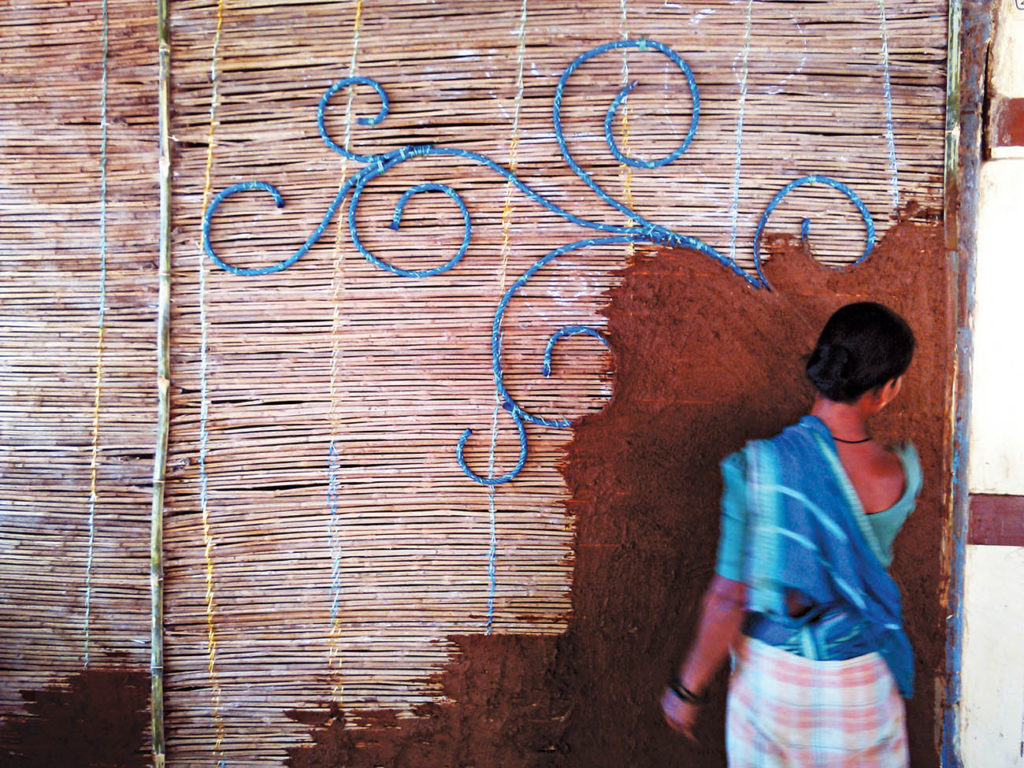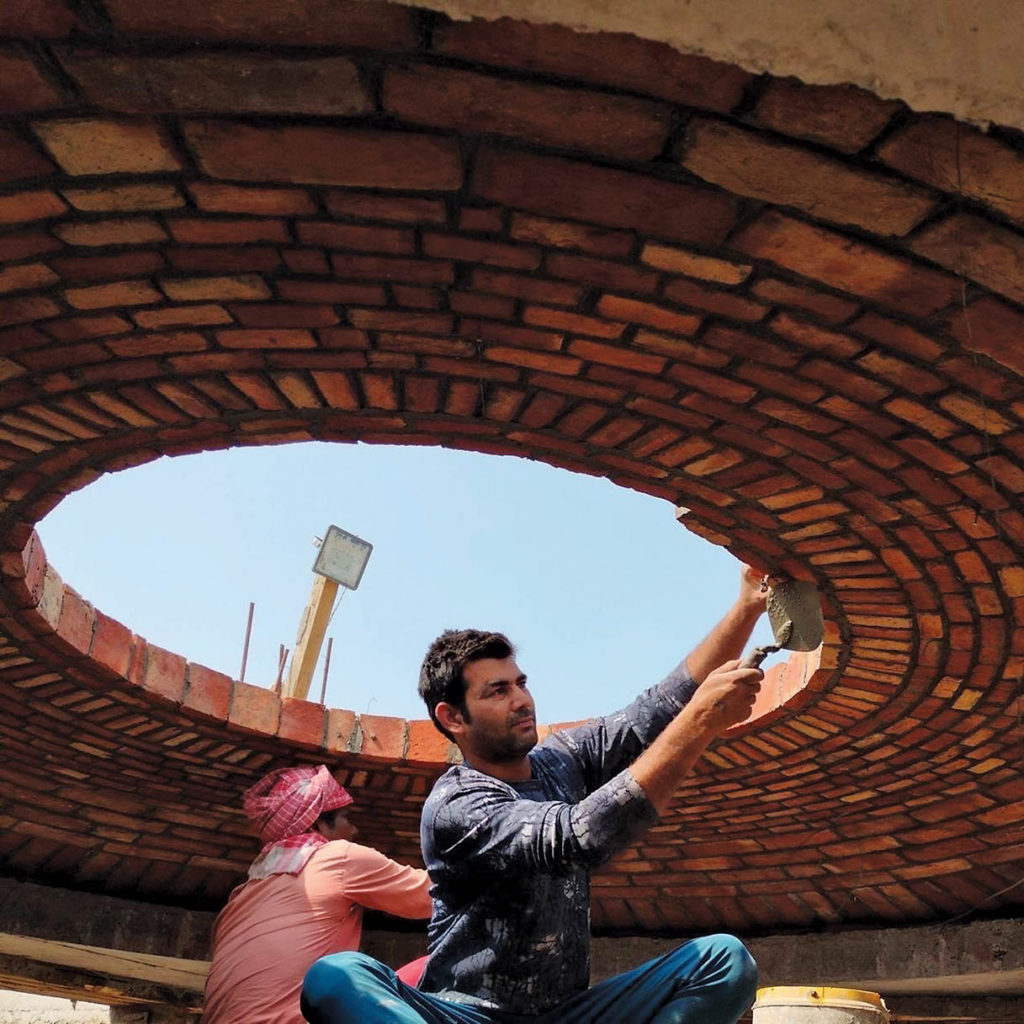Re-Emergence of the Vernacular in India
June 15, 2022


Lime plaster finishes applied on wall. Photo by Manu Narendran
Socially conscious people in India have begun looking for sustainable alternatives to building. They understand the benefits of building chemical-free; using natural materials and traditional building methods—something that has been done traditionally in rural India for ages. As such, they are not new, but were at the risk of being lost, since they were not passed down through formal architectural education and training to find ground due to industrialisation and influences from the West. However, because of this growing awareness and subsequent increase in demand, architectural practices are rediscovering and reviving lost techniques that use the least industrialised materials to design and build for better health and well-being in the long term.
MATERIALS
In India, cement is usually seen as a modern and forward-looking material. It has a historical perspective to it. After its independence in 1947, India was trying to find its identity—something overpowered by its colonial history. Jawaharlal Nehru, India’s first Prime Minister, invited architects like Le Corbusier to build “a new town, symbolic of the freedom of India, unfettered by the traditions of the past—an expression of the nation’s faith in the future”.1
Over time, many realised that sustainable living is the way of the future and are preferring traditional techniques, local materials and sustainable methods in contemporary designs. These methods use a minimum or negligible amount of cement, are chemical-free, and provide employment to local building artisans and workers.
Manu Narendran, a partner at Thumb Impressions Collaborative, is trying to find a middle path. He believes that a large-scale impact on a growing economy can be made only if these alternative materials and methods enter the mainstream. “People don’t have the luxury of time and money; they need ready tailor-made solutions.”

Types of wattle and daub in Palghar District
Lime
Narendran works with natural building materials and specialises in lime plasters—a lime-based wall plastering technique that is almost lost due to the introduction of gypsum-based applications and acrylic paints. Lime has properties that help in humidity and temperature regulation, and has been used on the walls of traditional houses and palaces for thousands of years. “Most of the people interested in getting lime plaster are looking for a healthy alternative in their lives, especially for their kids. They look for materials that are VOC5 free. And those who are well-travelled want surface finishes like Santorini Island buildings and Venetian houses,” added Narendran.
Wattle and daub
While people in the cities are now looking towards sustainable construction, many traditional houses are being demolished and replaced by cement and concrete ones in the villages. Such aspirations to emulate city life, however, have translated to high maintenance that is time-consuming for the residents, especially women, who are often tasked to do this job. Pratik Dhanmer, a friend and co-founder of Design Jatra—a firm based in Murbad, a village around 75 kilometres from Mumbai—shared that they are trying to focus on improving the local techniques by identifying the problem and coming up with a solution. They are working with wattle and daub6 (WD) construction—a local construction method used across tribal communities in India and especially among the Warli community.
CRAFTSMANSHIP
Azad is a traditional daat or flat dome maker hailing from Rohtak, a small town in Haryana, about 65 kilometres from Delhi. He comes from a family of traditional dome makers who make them just by the skill of their hand, without using any formwork: “I learnt it from my father who learnt it from another master artisan.”


Azad, with whom I have also worked in a recent project, told me that by 2014 his practice almost died down, so he left making domes and started working as a mason on sites. But over the past few years, contemporary architects slowly recognised his skills and started inviting him to their projects. He has built domes in more than 100 cities and has collaborated with many new and established architects by now. Following the tradition, Azad started training more artisans and now has two teams working on different sites simultaneously. He heads one, and another by his work partner Manish Siroha. “My dream is to earn some money for the next few years and start a dome-making school to teach interested architects the art of making flat domes by hand.”
[This is an excerpt. Subscribe to the digital edition or hardcopy to read the complete article.]

Nipun Prabhakar is an independent documentary photographer and architect based in India. He works on long-term projects dealing with intersections of ideas, artifacts, the built environment and folklore. His background as an architect has deeply impacted his sense of space in situations that call for a contextual response to culture and geography. His work has been supported by the Aga Khan Trust for Culture, AKDC at MIT, among others. He is a recipient of the Berkeley Essay Prize 2014 and was Cornell University’s South Asian Fellow 2019-20.
1 Khosla, Romi. “The New Metropolis: Nehru and the Aftermath.” Social Scientist, vol. 43, no. 3/4, Social Scientist, 2015, pp. 11–32, https://www.jstor.org/stable/24372933.
2 Tayyibji, Riyaz. ‘Gandhi’s Buildings and the Search for a Spiritual Modernity’. Post, 9 Jan. 2019, https://post.moma.org/gandhis-buildings-and-the-search-for-a-spiritualmodernity/.
3 Cement: Production Ranking Top Countries 2020’. Statista, https://www.statista.com/statistics/267364/world-cementproduction-by-country/. Accessed 25 Mar. 2022.
4 According to Building Material Promotion Council (BMTPC).
5 Volatile organic compounds (VOCs) are emitted as gases from certain solids or liquids like paints.
6 It is a technique of making walls with a woven lattice of bamboo slits (called wattle) and its daubed with a combination of wet soil, animal dung and straw.
7 Cob is a natural building material made from subsoil, water, straw, cow dung, and sometimes lime.
RELATED: Commentary | Reinforcing a Labour of Love

Read more stories from FuturArc 2Q 2022: New & Re-Emerging Architecture!

To read the complete article, get your hardcopy at our online shop/newsstands/major bookstores; subscribe to FuturArc or download the FuturArc App to read the issues.
Previously Published Commentary
Contact us at https://www.futurarc.com/contact-us for older commentaries.

